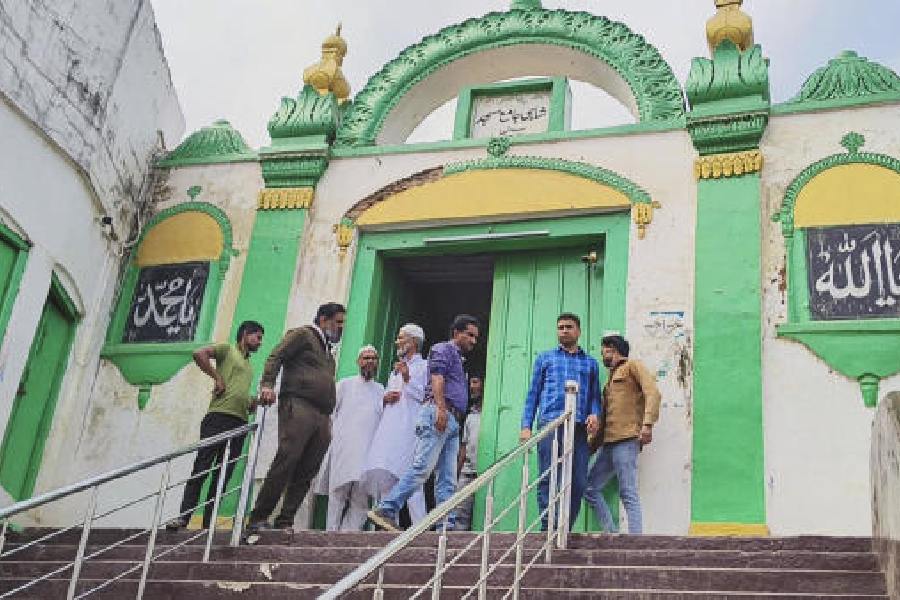 |
| Ganesh Pyne, The Night of the Merchant |
It was, presumably, one of those Central Calcutta houses that the 50s and 60s generations of the previous century are quite familiar with. Largish and somewhat rundown, it offered solitary niches to retreat to during somnolent afternoons. With the sun leaning across its windows and sentient shadows nestling in its deep recesses, a spectacle of light and darkness would be quietly enacted every day. In front of the house stood a wooden figure of Chaitanya in a temple, radiating a subtle magnetism. Nearby lived a neighbour whose house hosted jatra performances that stimulated the wide-eyed wonder of children in an age in which visiting the cinema or the theatre was considered something of an event. But captivating entertainment was provided by the wondrous tales that Grandmother narrated on the verandah in the evenings.
This was just the setting for the imagination of a sensitive child to invent his own private mythology. And a shy, withdrawn loner is what Ganesh Pyne was, even as a child.
What tales would a Bengali Hindu grandmother narrate in the early 1940s? Those from the epics, certainly. Religious fables, perhaps. And folktales, of course, that all children of that time would routinely hear, suitably embellished by the raconteur. Where the suo ranis (favoured queens) got their rival co-wife buried by the king with thorns above and below, monsters transferred their hearts to bumble bees that were safely locked up in little caskets as they prowled the night to gobble up children, the aged mother moon sat spinning eternally, and talking birds gave advice to the helpless. Fantastic stories of casual violence, deliciously macabre, that thrilled children secure in the knowledge that they themselves were beyond harm.
But suddenly, without a warning, the thrill spilled out into the real world for nine-year-old Ganesh when, during the Great Calcutta Killings, the family had to be escorted to a safe zone at Medical College. To be torn from his home, his intimate surroundings, to live the life of refugees at the camp must have been traumatic. And then he came across a sight quoted in almost every article on him: bodies heaped on a cart. Like carcasses. Nightmares, discovered the badly shaken boy, could be for real, too. Already, his father’s death earlier that year had given him a taste of contingencies beyond one’s control.
The shadowy niches of his childhood home, the strange, dark fantasy of his grandmother’s stories, the theatricality of jatra, and his traumatic encounter with death and violence came to besiege his memory, which would imbue the mundane with a mystique and gift him a rich and complex interior landscape to contemplate. Introverted, reclusive, reflective, the artist remained achingly tuned to the tremulous childhood core that shaped his sensibility and proved intrinsic to his art. Where the magical and the menacing mingled as easily as they did in Grandmother’s stories. And that — the haunting, obsessive dirge that casts a slow spell on the viewer in the best of Pyne — ensures for this figurative artist a quite unique place in the Indian arts where dark themes haven’t been too popular.
Literature and films here have, for example, often been obliged to carry positive messages, offer solutions, promise a new dawn after the darkest night. This could be partly because the overbearing weight of religious faith instils the acceptance of adversity — whether natural or manmade — with palliatives. Like the hope of common weal in what’s perceived as unfathomed divine design. Paradoxically, non-believers would hope for common weal in what would be interpreted as History’s design, on the other hand. Thus, ideologically committed writers and film-makers would be vulnerable to this invisible pressure. Even a genius like Satyajit Ray, for example, invented a happy ending for his Ganashatru which deviated from the Ibsen original in identifying people power as the ultimate redemption. Not surprising in a nation still in an experimental stage with its democracy and Western development models. And so the tragic vision hasn’t been too welcome, in spite of the enduring hold that the Mahabharat’s apocalyptic tragedy has had on the popular imagination.
And what about art? To look at the big names is to find that those who’ve been inspired by the pre-industrial idioms of folk and tribal communities celebrate life rather than mourn loss. Like Jamini Roy and Panikkar, for example. While Ramkinkar Baij is earthy and heady in his approach, Husain’s explosive energy is ever engaged with the life around. In fact, as a critic commented, his galloping horses seem to suggest India’s great push forward to catch up with the modern age in the 1960s and 1970s. Bikash Bhattacharjee, stimulated though he was by private symbolism like Pyne, is really focused on a strategy of acerbic social commentary. Jogen Chowdhury, who does indeed dwell on dark themes, also casts his gaze outwards as a satiric critic. And though the works of Tyeb Mehta are driven by angst, the tenor is more Western than Indian.
But there are two names that could readily be cited in Pyne’s context. One is Gaganendranath Tagore who, more than his brother, Abanindranath, was a significant influence, as the artist himself has owned. The unspoken yet mesmeric drama of glowing light and delicate shadows, geometric structures with surreptitious depths that also bring stage sets to mind, the cartoon figures with a breezy simplification of form were to be distilled into Pyne’s lexicon.
And there is yet another Tagore, rather ignored in Pyne exegesis: Rabindranath. The shadows, the fantastic creatures, the touch of the macabre create in his art a web of anxiety, mystery and inexplicable melancholy that inform the twilight images of Pyne, too.
And, interestingly, the poetry of Jibananada Das, who paints vividly with words. The sense of longing and loss that seep into the dense, sensuous beauty of nature in it defines a true original. Pyne, a declared lover of poetry, could nurture a poem in his mind for years before seeking to capture its tenuous imagery in his painting. That’s how Shakti Chattopadhyay’s Ami Swechhachari would inspire Harbour, reveals the critic, Ella Datta, in her book, Ganesh Pyne: His Life and Times. Whether or not the artist was similarly stimulated by Das, there’s an affinity of disquiet and twilight ambience in their works; the painful intimations of transience and mortality running through them speak of a shared sensibility, even though nature, per se, isn’t what we see in Pyne.
What we do see are enigmatic interiors and yawning voids, looming silhouettes and weathered creatures, bleached bones and ramshackle objects, theatrical daggers and boats and chariots, wrapped in a dim luminous sienna or a brooding night-time blue. Although candles and bulbs are a recurrent presence, the muted light doesn’t always have a logical source for Pyne is, like his inspiration, Rembrandt, his own sun god.
As an inheritor of the Bengal School legacy he’d started with watercolour; its limpid quality produced some fine work. Gouache, too, was used. But most of his truly memorable paintings are in tempera on canvas: the Chaitanya paintings, The Door, the Windows, The Wooden Horse, Archer, Warrior and so forth. However, one of his very best, The Night of the Merchant, is on paper. His treatment of light and the subdued palette presided over by beige and inflected browns — matte, textured or strangely radiant — with startling insertions of dense blues and red-maroons, weave a precarious evanescence into the images, insinuate the sinister, predict doom. By contrast, the dry media, even in his Mahabharat series, couldn’t quite match the mirage-like quality of his temperas.
Well, work could be uneven. It would be an unfair demand to expect otherwise. No genius has ever produced only masterpieces. Pyne himself was keenly aware of quality and, thus, remained frugal in his output. Yet the pressures of the market did force him to part with work he wasn’t always fully satisfied with. Besides, in the past decade, we didn’t get to see the kind of work that had given him his unquestioned place in Indian art. The two solo shows held in Calcutta during this time indicated a lean patch with pretty elements — which appeared as a seductive phantom of the Bengal School — surfacing a little too much, while the cadavers appeared somewhat routine.
But, interestingly, connoisseur interest was shifting during this phase to pages from his notebook known as Jottings. Its preliminary sketches, scratches and observations trace the fraught journey a creator must undertake battling doubts, unease and the elusive muse of the imagination. Pyne, always jealous of his privacy, finally allows the public to breach it.










